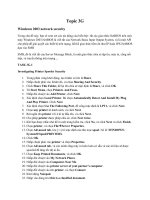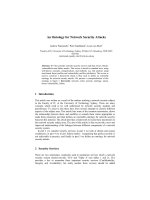Hardening security defenses against tomorrows DDoS attacks whitepaper
Bạn đang xem bản rút gọn của tài liệu. Xem và tải ngay bản đầy đủ của tài liệu tại đây (459.89 KB, 7 trang )
White Paper
Mike Jack, Sr. Product Marketing Manager
Spirent Security Solutions
Hardening Security Defenses
Against Tomorrow’s DDoS Attacks
Executive Summary
Today, Distributed Denial of Service (DDoS) attacks are
every network’s problem. Powerful computing platforms,
high bandwidth connections, low-cost hardware, global
reach, and the easy availability of “how-to” toolkits for
conducting DDoS attacks make wreaking havoc easy.
DDoS attacks are already more diverse than in the
past—and they change constantly. For the enterprise, this
knowledge is worrisome. But there are ways to preempt
attacks and know in advance how your infrastructure will
function in a DDoS attack.
This paper discusses current DDoS attack
methodologies, providing examples, to give you insight
into how your enterprise might be vulnerable, and
describes steps you can take to harden defenses through
preemptive security testing and measuring techniques.
Hardening Security Defenses Against Tomorrow’s DDoS Attacks
DDoS Attacks—An Inescapable Reality
In early 2019, DDoS attacks made headlines around the
world with the largest ever recorded attack that peaked
at over 80 million packets per second was recorded.
Today DDoS attacks include more targets become
larger, more diverse, potentially more dangerous, and
significantly more costly.
Numerous types of cyber attacks, including phishing,
use of spyware, hijacked accounts, and data leaks
were initiated to influence elections in several
countries. DDoS-style attacks occurred in the United
Kingdom and Australia. In the United Kingdom, the
voter registration website (Gov.uk/register-to-vote)
experienced a service outage when it was flooded
with requests just a few hours before the registration
deadline. As a result, the government extended
registration for another two days, which could have
significantly shifted voter demographics through social
manipulation.1 In the USA, Hackers have launched
distributed denial-of-service attacks against at least two
municipal-level Democratic campaigns in 2018.2
Q1 of 2019 has seen a 967% increase in major DDoS
attacks where over 77% of DDoS attacks sized 100Gbps
and higher were targeting two or more vectors. While
the largest DDoS attacks experienced the most growth,
smaller attacks also increased exponentially. In the past,
such attacks have limited access to or incapacitated
multiple websites, including Twitter, Amazon, Spotify,
Tumblr, Reddit, PayPal, Ticketmaster, HSBC, BankWest,
and Netflix.3
a Portland, Oregon cloud computing company with
DDoS attacks that crashed the French news websites
Le Monde and Le Figaro.4 June saw DDoS attacks on
Qatar-based news network Al Jazeera’s websites and
internal systems.5 And in the U.S., a botnet generated
a DDoS attack against the Federal Communications
Commission’s website, temporarily disabling it.
Costly Chaos
Early DDoS attacks were typically used to showcase the
perpetrator’s ability to disrupt service and create chaos.
The attacks evolved into protest mechanisms and are
now used to extort money, manipulate currency rates,
and intimidate. For example, when Bitfinex, the world’s
largest Bitcoin exchange, began trading IOTA crypto
currency tokens in June 2017, it was hit by a DDoS
attack that many experts believe was motivated by a
desire to manipulate exchange rates.6
As another example, in late June, a group calling
itself the “Armada Collective” threatened seven South
Korean banks with DDoS attacks if they did not each
pay ransoms of $315,000. The Armada Collective
apparently was emboldened by the $1 million ransom
payment made by a South Korean web hosting
company a week earlier to avoid DDoS attacks.7
“Cyber Attacks on French Election,” Radware, April 21, 2017,
www.radware.com.
1
/>
2
/>
3
As recently as late 2018, DDoS attacks have continued
to target a myriad of different websites. A popular
online code management service used by millions of
developers, GitHub is used to high traffic and usage.
What it wasn’t prepared for was the record breaking
1.3 Tbps of traffic that flooded its servers with 126.9
million packets of data each second. The attack was
the biggest recorded DDoS attack, but amazingly the
onslaught only took GitHub’s systems down for about
20 minutes. This was largely due to the fact that GitHub
utilized a DDoS protection service that detected the
attack and quickly took steps to minimize the impact.
Later that year, politically motived attackers targeted
2
Nick Ismail, “Major French news sites victim of DDoS attack,”
Information Age, May 11, 2017, />major-french-news-sites-victim-ddos-attack-123466206.
4
John Leydon, “DDoS attack brings Qatar’s Al Jazeera website to
its knees,” The Register, June 9, 2017, register.
co.uk/2017/06/09/al_jazeera_battered_by_ddos_attack/.
5
Phil Muncaster, “World’s Largest Bitcoin Exchange Bitfinex
Crippled by DDoS, InfoSecurity,” June 15, 2017, https://www.
infosecurity-magazine.com/news/worlds-largest-bitcoin-exchange.
6
Catalan Cimpanu, “$1 Million Ransomware Payment Has Spurred
New DDoS-for-Bitcoin Attacks,” Bleeping Computer, June 26, 2017,
/>
7
Why DDoS Attacks Are Increasing
It’s relatively easy and inexpensive for a bad actor to create chaos or extort money using DDoS attacks.8
IoT Devices are Everywhere and Not Secured
Botnets Sold or Rented on the Dark Web
All network-connected devices, such as video
surveillance cameras, webcams, baby monitors, home
routers—even TVs and refrigerators—have IP addresses
and usually lack robust protection against security
vulnerabilities and cyber attacks. By injecting code into
a single webcam, an attacker can broadcast a highly
distributed attack as the malicious code propagates
to other vulnerable devices. The Mirai botnet included
millions of IoT devices around the world. With more
than 6.4 billion IoT devices currently connected and an
additional 20 billion devices expected to be online by
2020, the IoT botnet business is booming.9 Additionally,
source code for the Mirai attack is opening available
for anyone to study, analyze and potentially use for a
future attack.
Want to launch a DDoS attack? Get out your bitcoin
wallet—botnets are readily available. On the dark net,
you can find a botnet vendor, decide how many you
want to purchase or rent, determine how long you’ll
need them, and specify the country (or countries) in
which you want them to reside. Prices range from 25¢
to $1 per host, with minimum orders of around 50-100.
You can also buy IoT botnet stressers to use for service
periods ranging from a day to several months. Stressers
allow you to launch a limited number of attacks per day
with a guaranteed minimum duration ranging from a
few minutes to a few hours.
Botnet purveyors trade in crypto currency to evade
payment trails. As long as crypto currency maintains
value, the dark web economy will thrive.10
“The Cost of a DDoS Attack on the Darknet,” Radware blog, March
15, 2017, />
8
Ibid.
9
10
Radware blog, March 15, 2017, op cit.
3
Hardening Security Defenses Against Tomorrow’s DDoS Attacks
DDos Attack Size in Gbps
1400
Size of Attacks
1200
1000
800
600
400
200
0
2004 2005 2006 2007 2008 2009 2010 2011 2012 2013 2014 2015 2016 2017 2018 2019
Years
Preparedness: The Next Best Thing
to Immunity
• A total of 86% of the organizations surveyed had
experienced multiple DDoS attacks.
No enterprise is immune to DDoS attacks, but the next
best step is preparedness. If your organization hasn’t
yet experienced a DDoS attack, it’s only a matter of
time. You can take three fundamental steps to harden
defenses against DDoS attacks:
• Of the organizations experiencing multiple attacks,
63% said that revenue losses at peak time could
exceed $100,000 per hour, while 43% said financial
losses per hour were actually closer to $250,000.
1.Become aware of the current DDoS landscape
2.Understand how DDoS attacks work
3.Recognize the challenges involved in creating a
defense strategy
Survey the DDoS Landscape
If you have experienced a DDoS attack, you’re not
alone. Even if you haven’t, there’s little comfort in
findings indicating that you probably will. Web
analytics firm Akamai surveyed 1,010 enterprises in
early 2019 and issued their results in May. According
to Neustar’s Worldwide DDoS Attacks & Cyber Insights
Research Report:
• A total of 849 organizations had experienced at
least one DDoS attack in the previous 12 months,
representing 84% of the organizations surveyed and
an 11% increase (from 73%) in 2016.
4
• Survey respondents had lost more than $2.2 billion
collectively in the previous 12 months, a minimum
of $2.5 million for each of the 849 organizations
experiencing attacks.11
Neustar found that 45% of DDoS attacks were stronger
than 10Gbps, and 15% reached at least 50Gbps—
almost double the rates reported in 2016. In addition
to using IoT devices to carry out attacks, attackers
employed a variety of new techniques, such as Generic
Routing Encapsulation (GRE)-based flooding and
Connectionless Lightweight Directory Access Protocol
(CLDAP) reflection.12 These findings suggest that
enterprises recognize the probability that one or more
DDoS attacks on their organizations will occur and that
DDoS attacks will continue to increase and diversify.
11
2019 State of the Internet/ Security: Credential Stuffing - Attacks
and Economies, Apr, 2019
12
Ibid.
Understand How DDoS Attacks Work
DDoS attacks are designed to make an online service
unavailable by overwhelming it with traffic from
multiple sources. Stopping DDoS attacks is more
difficult than stopping other types of cyber attacks.
There are different types of DDoS attacks, and each
must be addressed in a different way. The three most
common types are:13
• Volumetric attacks. These attacks saturate an
organization’s bandwidth with massive amounts of
traffic. They are measured in bits per second and
are commonly known as UDP Flood, TCP Flood, or
Amplification attacks.
• Protocol attacks. These attacks exploit weaknesses in
the Layer 3 or Layer 4 protocol stack. They consume
all of the processing power of the target or of devices
like firewalls. Syn Flood and Ping of Death are this
type of attack.
• Application attacks. These are the most
sophisticated types of DDoS attack and the hardest
to identify and mitigate as they appear like legitimate
user sessions. They establish a connection with
a system and then monopolize processes and
transactions, causing system crashes. In many cases
application attacks do not require large volumes of
traffic to cause system failures. HTTP Flood and DNS
attacks are examples of application attacks.
Hackers stay ahead of the curve, continuously
looking for new vulnerabilities and coming up with
new techniques. They might use a DDoS attack as a
smokescreen to divert attention and resources from
a second location being compromised through other
malicious methods. Not only can Botnets overwhelm
networks, they can establish command-and-control
presence for executing code, self propagation and
exfiltrating data.
For these reasons, an enterprise can be affected by
DDoS attacks through means that are completely
unrelated to its business. One such example is a s a
late 2019 DDoS attack on the Swedish Democratic
Party’s website at the end of August. Later that year,
a mass attack targeting D-Link routers was launched
when an attacker used Mirai malware to hijack routers,
surveillance cameras, and baby monitors in a major
DDoS attack.
Recognizing the Challenges When
Formulating a Defense Strategy
DDoS attacks create tremendous challenges for
an enterprise. For example, you need to balance
protection against DDoS attacks with enterprise
network access and performance requirements. The
ideal balance is different for different enterprises.
In addition, enterprise IT and security teams already
have their hands full. The ability to add new security
measures and policies is often limited by available
resources and budgets. Developing the most effective
and achievable defense requires you to identify and
prioritize the potential chokepoints that are the most
vulnerable to a DDoS attack.
Hardening Security Defenses
Since immunity from DDoS attacks is not an option,
the best defense is to take a proactive, preemptive
stance. Start to build protection into future products or
services by incorporating security measures into your
development processes. In the meantime, take the
following steps to harden your defenses against DDoS
attacks.
Think Holistically and Be Proactive
First, think holistically and proactively. DDoS attacks
typically affect multiple points in a network. Enterprises
must decide which processes, paths, applications,
and users are absolutely mission-critical for enterprise
performance. Identifying mission-critical points will
help determine the balance between optimal amounts
of protection and access in order to simplify decisionmaking and prioritize actions.
13
Archana Kesavan, “Three Types of DDoS Attacks,” Thousand Eyes
blog, November 15, 2016,
/>
5
Hardening Security Defenses Against Tomorrow’s DDoS Attacks
Fix What You Can—Now
Call the Experts
Test, Test, Test
One of the most important
measures for hardening defenses
against DDoS attacks is to make
certain that enterprise networks
and systems are not running
on manufacturers’ default
configurations or security
measures. Use of default
configurations is one of the most
common—and preventable—
vulnerabilities. Next, take
advantage of next-generation
firewall capabilities for DDoS
mitigation. If firewalls or other
security infrastructure components
are due for a refresh, replace them
with solutions that provide
DDoS mitigation.
Consult DDoS protection experts
for advice and resources. Look
for experience in devising and
validating DDoS mitigation
strategies against volumetric,
protocol, and application attack
types. In addition, seek out testing
expertise that delivers realistic
results about the impact of a DDoS
attack in your environment.
Test preemptively—and regularly.
Preemptive testing helps ensure
that your infrastructure performs
as expected in case of a DDoS
attack. Repeat preemptive testing
every six months, or when major
infrastructure changes occur, to
continue to match defenses to
current DDoS threats.
For example, Spirent uses its
CyberFlood solution to combine
legitimate and normal traffic with
DDoS attack traffic in emulating a
real-world DDoS attack on a test
network. CyberFlood provides
real-time statistics that enable you
to measure user experience and
security mitigation simultaneously,
so that you know exactly how
your security infrastructure is
performing.
Create Comprehensive tests with global IP sources, mixed attack and normal user traffic
6
Hardening Security Defenses Against Tomorrow’s DDoS Attacks
About Spirent
Communications
Spirent Communications
(LSE: SPT) is a global leader
with deep expertise and
decades of experience
in testing, assurance,
analytics and security,
serving developers, service
providers, and enterprise
networks.
Begin Today
Understanding the current DDoS attack landscape and gaining insight into
potential vulnerabilities can go a long way toward successfully mitigating a
DDoS attack. Knowing that you’re not alone—that experts in DDoS testing and
mitigation are able to assist in hardening your defenses—is empowering. Let
Spirent help you preempt DDoS attackers and minimize risk.
We help bring clarity to
increasingly complex
technological and business
challenges.
Spirent’s customers have
made a promise to their
customers to deliver superior
performance. Spirent assures
that those promises are
fulfilled.
For more information, visit:
www.spirent.com
Contact Us
For more information, call your Spirent sales representative or
visit us on the web at www.spirent.com/ContactSpirent.
www.spirent.com
© 2019 Spirent Communications, Inc. All of the company names and/or brand names
and/or product names and/or logos referred to in this document, in particular the
name “Spirent” and its logo device, are either registered trademarks or trademarks
pending registration in accordance with relevant national laws. All rights reserved.
Specifications subject to change without notice.
Americas 1-800-SPIRENT
+1-800-774-7368 |
Europe and the Middle East
+44 (0) 1293 767979 |
Asia and the Pacific
+86-10-8518-2539 |
Rev C | 05/19









